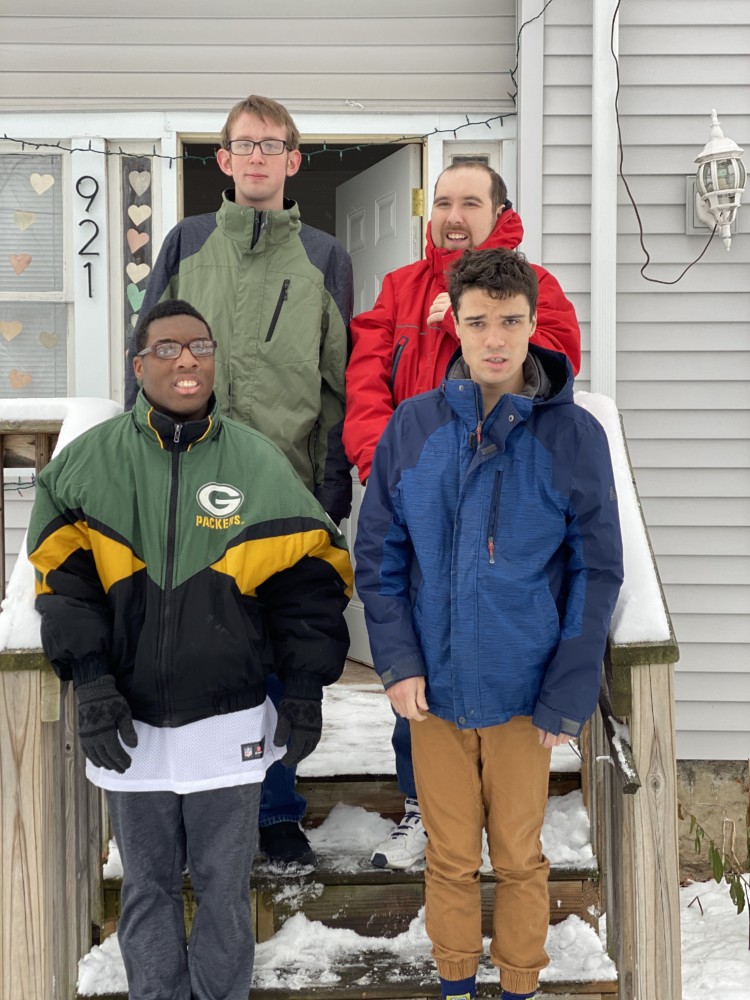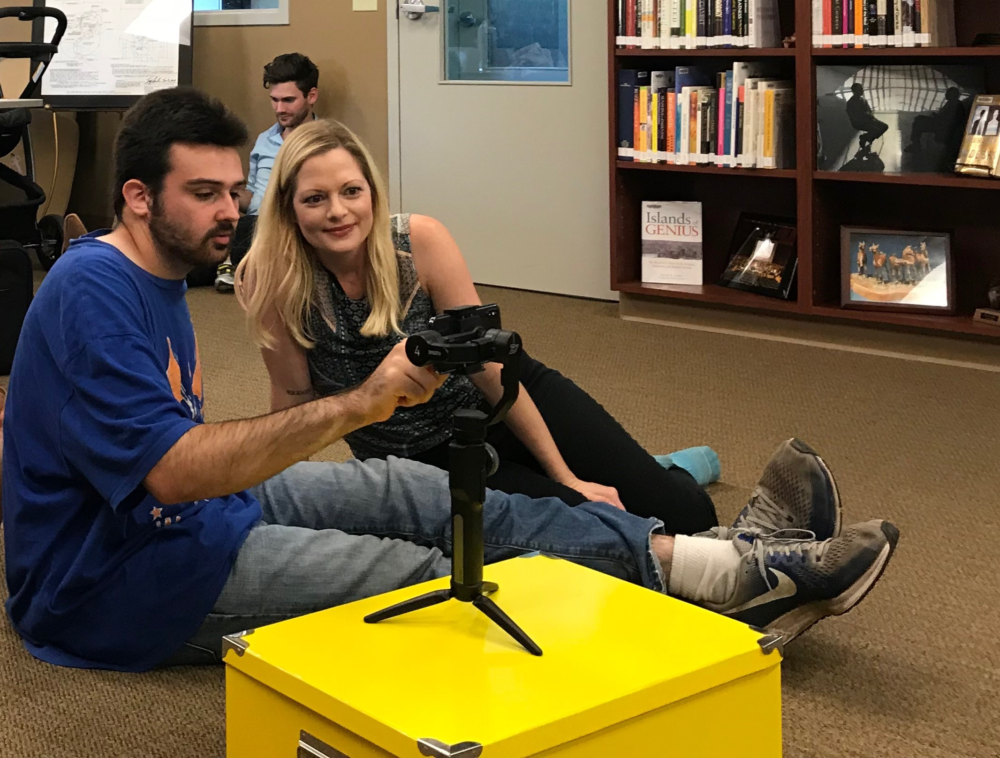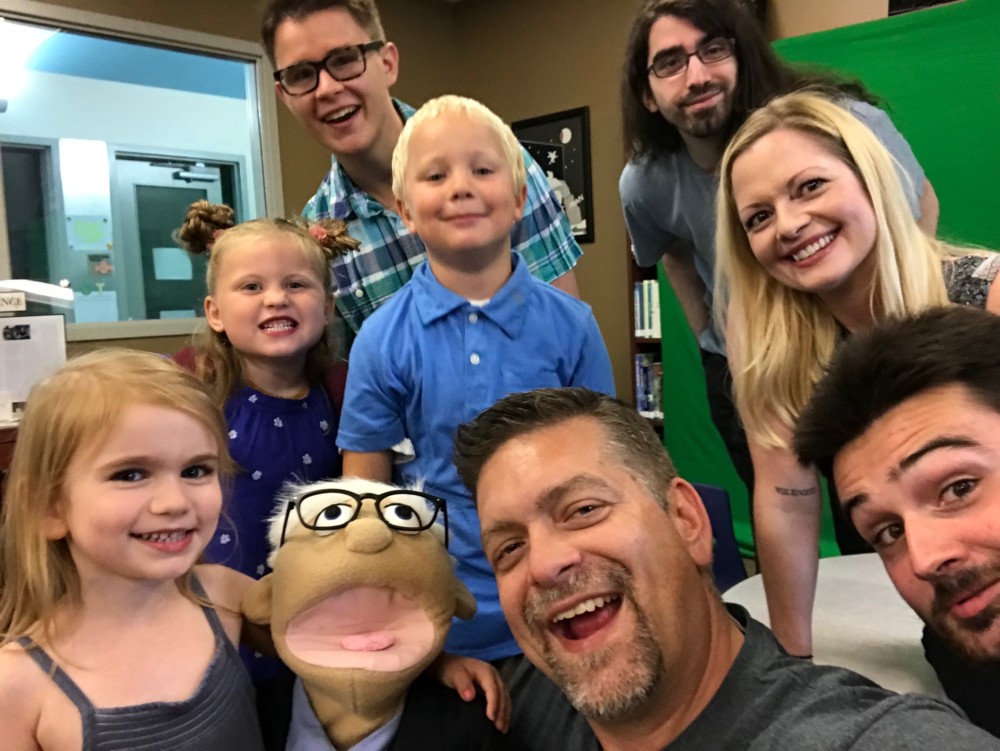Independent Living for Adults with Autism

The Treffert Center in Fond du Lac provides outreach for adults with autism. Photo by Kacie Mischler Bass.
Adults living with autism experience distinct challenges as they age out of youth support programs
“If you’ve met one person with autism, then you’ve met one person with autism.”
This phrase is said often within the Autism Spectrum Disorder community, often with a knowing smile from both the speaker and listener. The middle word in Autism Spectrum Disorder (shortened as ASD) is a very apt choice in the name, for individuals living with autism can have a wide range of possible features.
Diagnostically speaking, autism has three levels, with level one requiring some additional support and level three requiring very substantial support. However, many experts within the community discourage putting too much focus on level and instead emphasize helping each individual person.
The Autism Speaks website says that ASD “refers to a broad range of conditions characterized by challenges with social skills, repetitive behaviors, speech and nonverbal communication.” Signs of autism may include difficulty interpreting social interactions, trouble with planning and organization, frequent repetitive conduct, narrow and strong interests, distress over change, and deficits in verbal communication. An individual certainly does not need all or even most to receive an autism diagnosis.
Haley Fredericks, a 30-year-old Appleton resident who loves storytelling and prides herself on being insightful, says, “For me, being autistic is like being plunked down on an alien planet with a culture and social norms [and] constructs beyond [my] understanding, yet being forced to wear a mask and blend in with them.
Early indicators and an autism diagnosis can happen for people as young as 18 months to 3 years of age or be delayed years due to missed signs. For families of children living with autism, it can take some adjustment time to learn how best to support the child.
But there is a whole new set of considerations as children with autism approach adulthood. School programs, which are often integral in the support team, are no longer available, and new challenges arise such as housing, employment and social independence. Autism awareness has expanded greatly over the last several decades, but so much emphasis is put on children and early intervention that it is easy to forget that children with autism grow up to be adults with autism.
HOUSING
Justin Krueger is the owner of Your Neighborhood Living, a company that runs three adult family homes in the Fox Cities with four residents in each for people, most with autism, who cannot live on their own. Krueger loves working with young adults with autism because “they are so full of life.” He believes that they owe a debt to their community for supporting them, and so he creates opportunities for them to do just that. The staff and residents conduct food drives, pick up litter, ring bells for the Salvation Army, make letters to nursing home residents, and more. Pre-COVID, Krueger says they would spend at least five nights a week out in the community, having fun and bringing joy to people with their smiles and high fives.
“These people have a purpose. Their job is to brighten and make the community smile. It’s important that they’re visible in the community,” Krueger says.
When not out and about, Krueger and his staff supervise the hygiene schedule of residents (his motto is “look good, feel good, smell good”), watch “The Price is Right” (“a big hit” in all three houses), drive residents to work (a sheltered workshop at Valley Packaging), and help residents cook and do laundry.
Your Neighborhood Living obviously has a great system going, but Krueger only has space for 12 adults. He says, “Yes, there is a shortage for housing, but the bigger problem is there is a financial shortage from the state level. There will be a looming crisis.”
Krueger is referring to the fact that the cost of living goes up each year, but the allocation of funds for companies like his do not. “For every one person who says, ‘Yes, we should raise taxes so we can provide more or better housing,’ there’s three or four people who say, ‘Don’t you dare touch my taxes.’”
Even more alarming, Krueger says that he draws his staff members from the same pool of employees who are needed in elderly care facilities, whose need is increasing. “Those assisted living places are able to pay better because they target private pay individuals rather than state funded individuals.” For now, Krueger has a wonderful staff who supervises the homes 24/7, but he hopes he can keep up with the competitive compensation offers of private institutions in the years to come.
Carrie Forster is the mother of one of Krueger’s residents. Her son Alex is a 30-year-old Kaukauna native whose journey to living in an adult family home was many years in the making.
“We started planning and researching about 15 years before Alex moved out,” Forster says. It takes a lot of thought and preparation for a successful adult housing plan for someone like Alex, who is nonverbal and needs direct care whenever he is awake. First, there is simply the decision whether an adult with autism should move away from their parents.
Forster says, “I think there’s a stigma against having your child move out. I know many parents who have told me they would never let someone else care for their child.” It can be a very personal decision, and there are not many resources to help families decide. “Nothing in the way the system is set up really prepares you or moves you toward making this choice for your child once they grow up,” Forster says.
While it is wonderful that parents want to continue to care for their adult children, there are several problems with this arrangement that many people like the Forsters face. After Alex graduated from school and before he moved out, he needed somewhere to go during the day while his parents worked. Many places that offer day services for adults do not have long enough hours for working parents.
One of the scariest thoughts many parents have is what will happen to their child when they are gone. If the Forsters chose to keep Alex at home as long as possible, they were looking at an eventual scenario where he would be uprooted to a group home in later middle age, with perhaps no personal advocates for him at all, while dealing with the emotional loss of his parents. Their choice to move him to an adult family home in his 20s allowed them to manage the whole process in the least traumatic way. Not only do they visit Alex and bring him back to their home often, but they were able to take the time to find the best housing fit for him. No one can do that better than a loving guardian who knows the adult well.
Even once the decision is made to transition to an adult family home or group home, the difficulties do not end there. Forster says that the whole process is “very confusing and time consuming.” Not every parent has the time or ability to do the necessary research, and Forster believes her background helped her manage it easier. Workshops and training sessions from programs like the Autism Society of Greater Wisconsin, the Autism Society of the Fox Valley and CESA 6 can also help.
Forster’s early research took her to the Aging and Disability Resource Center, where she says that the elderly are lumped together with adults with disabilities. The overarching goal of the program is to keep people living at home, but this goal, while appropriate for the elderly, is not as fitting when applied to people like Alex.
“That [goal] looks different if you’re 76 and having health issues that make it difficult for you to care for yourself. Supports in your home could keep you out of a skilled nursing facility. If you’re 25 and need around the clock support, like Alex does, I don’t think that the goal should necessarily be to keep you at your mom and dad’s house,” Forster says.
Despite knowing what they wanted to do for Alex, Forster implies that moving him out was not easy. She wouldn’t change it, though. “It’s hard to let go, but it felt like the right thing for him.”
EMPLOYMENT
Individuals who need supervised housing are not the only people with autism who might have special concerns about their living arrangements. Even those who don’t need caretakers can have difficulty finding success living away from a parent or guardian. One of the most stressful endeavors for these adults is finding fulfilling sources of income that can finance independent living.
Fredericks says that “[job] interviews are definitely the toughest part. I always have anxiety any time I interact with people, especially when I know the point of said interaction is to be judged for a position. That’s when I’m always afraid my faults will overshadow my assets.” Fredericks has worked as a general cleaner for about a decade. Like many people living with autism, Fredericks also has a strong aversion to phone conversations, which can be a major obstacle to employment.
Craig Wehner, program manager with the Department of Workforce Development, Division of Vocational Rehabilitation says that adults with autism can find different parts of the job process challenging, but that “generally, communication barriers in interviews and written communication seems to be a regular challenge.” Knowing how to engage with people can be tricky enough normally, but when the pressure of a job outcome is added, it can really be a struggle for adults with autism who would otherwise be great candidates.
Sara Kaiser, an MBA who works at the Treffert Center says, “Each year, approximately 100,000 ASD children turn 18, but just 58% will work for pay before the age of 25 compared with 74% of young adults who have intellectual disability and nearly 99% of all high school graduates.” Most people are surprised to hear these sorts of statistics.
It is not a matter of capability, as people with autism can be very strong employees and have a lot of talent. It can simply be that the typical process of job hunting favors people with certain attributes such as initiative, poise and gregariousness. This prejudice does not seem to be something that will be changing soon, and employers are missing out because of this adherence to traditional procedure.
Wehner says that workers with autism can be a great asset due to their different perspectives. “Communication can be nontraditional, and speed or style of communication doesn’t determine ability,” he says. The initial application and interview process are such a short part of a person’s career and may have nothing to do with the type of work the person is even applying for, yet it is a barrier for entry that must be passed successfully.
Fredericks is an example of a great employee who happens to have autism. “I think I’m a loyal and hardworking employee. … I’ve worked long hours and covered hard shifts when we were short, and I’m reliable too since I don’t like letting people down,” she says. Because of her distaste for job hunting, Fredericks is also someone who will stick around for a while, which is always a good quality in an employee.
Muenster shares that “there are people on the spectrum who are great cooks, authors, editors, sales reps, customer service reps, dispatchers, actors, auto mechanics, welders and the list goes on.” There is no perfect career for people with autism because they are just as diverse as the general population and can be just as successful if given the chance to prove it.
A possible problem for adults who fall towards the level-one end of ASD can be the “invisible disability” aspect. They can present as neurotypical, or not having a developmental disorder, and can therefore have their needs overlooked, when in fact certain simple accommodations would help them greatly. It falls to these adults to decide if they wish to disclose their autism or keep it to themselves, potentially making their lives harder or leading to an uncomfortable discussion with someone they do not yet know very well. If they choose not to disclose, then that can add pressure to mask their autism traits.
Kirsten Cooper, executive director at Autism Society of Greater Wisconsin, explains that “masking is when there is a discrepancy between how someone acts within a social context as compared to what they’re feeling on the inside,” and it can be mentally damaging.
Wehner says that people often expect the individual with autism to change themselves to fit the status quo, rather than making environmental or procedural changes to suit people who are different, which could benefit the organization and community as a whole as well as the individual.
Fredericks agrees, saying, “I think a lot of extra pressure might be taken off if employers became more open about that part of the workforce rather than expecting us all to pretend we’re neurotypical.”
Bryan Mischler, a licensed clinical social worker at the Treffert Center also echoes the idea that people with autism can be very valuable to their companies. “Many of these individuals have strengths in the areas of mathematics, science, memory, art, music, visual arts, computer programming and many other areas. Largely what this community needs is a greater understanding of autism and finding creative ways to utilize these talents to make our communities better for everyone.”
SOCIAL INDEPENDENCE AND SELF-ESTEEM
Once the basic requirements of survival are fulfilled, there is the idea of life satisfaction to consider. Adults with autism are no different from the neurotypical in that they crave connection and relationships, even if they do not show it in traditional ways. One of the most notable features of autism is a struggle with interpreting others’ behavior, reading nonverbal communication and managing social anxiety.
Lexi Parker is a 24-year-old Combined Locks woman with autism who loves drawing, reading and music.
“I really wish I had more time [in school] on improving my social skills. I struggle with starting and maintaining a conversation,” she says. “I find it hard to keep a conversation because I struggle with thinking of things to say on the fly. I’ve learned that open ended questions work better at helping me get a conversation going.”
Parker was only diagnosed with autism in high school, despite some early signs. Because of her late diagnosis, she was not able to participate in children’s programs. Parker says that after a childhood marked by never fitting in, finding a supportive community in her church over the last several years has come a long way in helping her to feel accepted and valued.
“I do believe that there should be more support for adults in terms of socialization. I never really got the help in this area, and I’m finding that I’m learning certain skills on my own,” she says.
Fredericks explains that conversations are easier for her if they follow a predetermined format, like when ordering food, for example. “However, when it doesn’t, it’s much harder and causes my anxiety to skyrocket. … In a society built around the socially competent mindset, it’s been especially difficult living with an inherent disadvantage. Also, because I’ve felt conditioned to hide my autism, I have a hard time opening up about why and where my struggles come from.”
Nonprofit organizations like SOAR Fox Cities are designed to help make it easier. Adults who are no longer in school have lost that built-in community and need new social options. Executive director Erin Schultz says the goal is to “increase your social connectedness, which helps the mental health and physical health, and we do that through X programming.” SOAR provides social opportunities for children and adults, respite opportunities for families and educational programming.
But even programs designed for them can be intimidating. A common struggle for people with autism is a certain level of large group anxiety. Schultz says that an unexpected result of the pandemic was a greater interest in virtual programming. When they switched over, they received interest from people who had never felt comfortable participating before. “[Participants] can start with their camera off and their microphone off. They can control the volume so it isn’t overly sensory,” Schultz explains. This makes participation a much gentler experience.
Discovering new methods to draw in those adults who aren’t inclined to leave the safety of their comfort zone should be a priority for local organizations. Like in the workplace, adults with autism bring many great traits into their friendships, such as loyalty, humor and fascinating knowledge, just to name a few. They are definitely worth getting to know on a deeper level.
HOW THE COMMUNITY CAN HELP
As with many social movements, it should not be solely the responsibility of a particular community to make their lives better on their own. There is a lot that other people can do to help.
Cooper says, “We hear from a lot of people with autism that they don’t feel welcome at community events, and so a direct invitation can go a long way.” This could apply to any event, large or small. If you know someone with autism that might need a little nudge to feel wanted, it is great to give a little one-on-one encouragement.
Tara Geier, BCBA, ESDM Practitioner at the Treffert Center says that our community members can ask questions and make modifications to be more inclusive. “More transitional housing, on-the-job supports, police and first responder trainings, altering environments to be more sensory friendly — these are just some things we can all start doing more of,” Geier says.
Cooper shares that in her experience, people with higher support needs have their strengths overlooked, while individuals whose autism is more invisible have their needs overlooked. Either scenario “can have a significant impact on mental health and overall wellness,” she says. It is important to maintain the balance of appreciating a person’s value while also acknowledging their differing needs.
It is also okay to just ask if you are not sure. It bears repeating that everyone has different needs, and that it is not polite nor useful to assume. Cooper says, “Asking autistic individuals if there is anything else you can do to support their participation is also a basic step.” Once you know, then follow through on reasonable requests.
Schultz wants people to consider that possibility of invisible disability. “If someone is a little socially shy or socially awkward or quiet or quirky, just recognize that they are possibly not neurotypical and just be kind,” she says. Sometimes that is all that is needed for a person to feel appreciated and welcome.
Fredericks would simply like more autism awareness for the adults. “We’re expected to have figured out how to exist within the public and make our way without [support], when the reality is that autism is a lifelong disability.” While there are coping mechanisms to be learned and organizations made to help, autism is not something that is outgrown. And we should not want it to be. Fredericks sums it up perfectly. “Some real superpowers can come from people like us, if the time is just taken to see that.”
A very special thank you to all sources who contributed to this story. Some were not quoted in the final article due to space and scope:
Kelly Brodhagen, Resource Specialist, Autism Society of Greater Wisconsin
Matthew Doll, Ph.D., Treffert Center
Harriet Redman, Founder and Executive Director, WisconSibs, Inc
Feature photo by Treffert Creative Media Team.















Leave a Comment